7BUnit6Reading1教学设计
- 格式:doc
- 大小:36.00 KB
- 文档页数:2
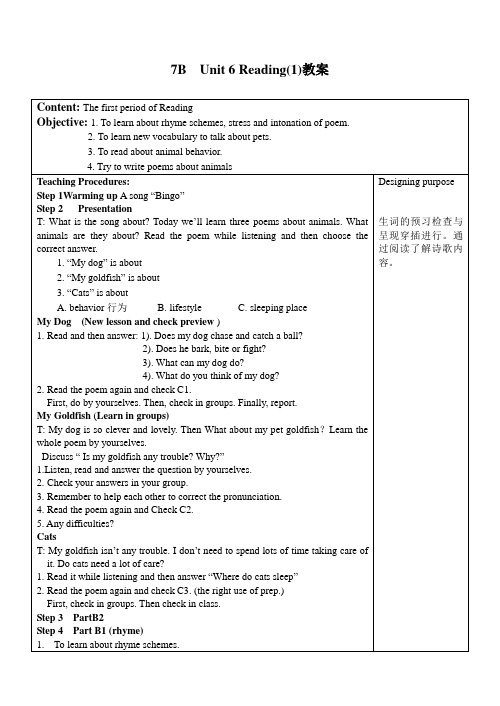

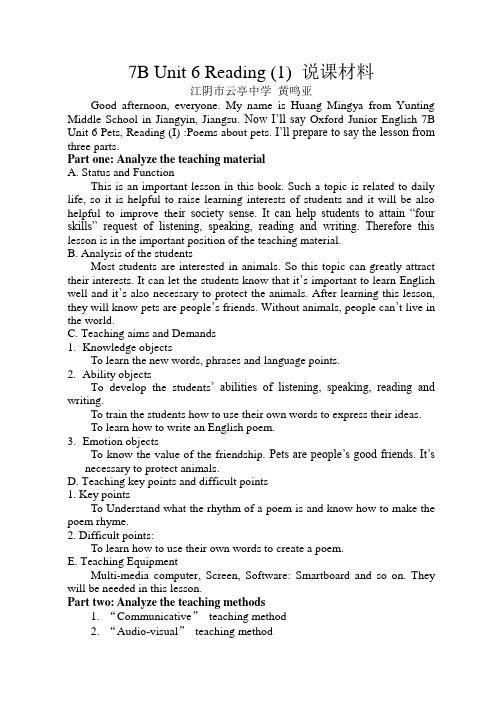
7B Unit 6 Reading (1) 说课材料江阴市云亭中学黄鸣亚Good afternoon, everyone. My name is Huang Mingya from Yunting Middle School in Jiangyin, Jiangsu. Now I’ll say Oxford Junior English 7B Unit 6 Pets, Reading (I) :Poems about pets. I’ll prepare to say the lesson from three parts.Part one: Analyze the teaching materialA. Status and FunctionThis is an important lesson in this book. Such a topic is related to daily life, so it is helpful to raise learning interests of students and it will be also helpful to improve the ir society sense. It can help students to attain “four skills” request of listening, speaking, reading and writing. Therefore this lesson is in the important position of the teaching material.B. Analysis of the studentsMost students are interested in animals. So this topic can greatly attract their interests. It can let the students know that it’s important to learn English well and it’s also necessary to protect the animals. After learning this lesson, they will know pets are people’s friends. Without animals, people can’t live in the world.C. Teaching aims and Demands1.Knowledge objectsTo learn the new words, phrases and language points.2.Ability objectsTo develop the students’ abilities of listening, speaking, reading and writing.To train the students how to use their own words to express their ideas.To learn how to write an English poem.3.Emotion objectsTo know the value of the friendship. Pets are people’s good friends. It’s necessary to protect animals.D. Teaching key points and difficult points1. Key pointsTo Understand what the rhythm of a poem is and know how to make the poem rhyme.2. Difficult points:To learn how to use their own words to create a poem.E. Teaching EquipmentMulti-media computer, Screen, Software: Smartboard and so on. They will be needed in this lesson.Part two: Analyze the teaching methods1. “Communicative”teaching method2. “Audio-visual”teaching method3. “Task-based”teaching methodAs we all know: the main instructional aims of learning English in the Middle School is to cultivate students’ abilities of listening, speaking, reading, writing and their good sense of the English language. So in this lesson I’ll mainly use “Communicative” teaching method, “Audio-visual” teaching method and “Task-based” teaching method. They are helpful to develop the students’ abilities.Part Three: Studying ProceduresStep 1. RevisionAsk Ss to make up a dialogue about their pets. Give them a model like this: “——Which is your favourite pet? ——I like dogs best. ——Why? ——Because they can help people do a lot of things. …” Call 2 or 3 Ss to act out their dialogues.Step 2. Warming-up activity1. Ask Ss a question: How many animals can you see in the flash? Play the flash and check the answer.2. Show a picture of Li Bai and a Chinese poem to Ss. Write “rhyme” on the screen.). Point out the words thay rhyme with each other.Step 3. Presentation1.Show some pictures of dogs to Ss. Teach the new words and phrases. Readthem together.Step 4. ListeningAsk the question: “Does the dog like to fight?”Play the tape for Ss to listen and answer.Step 5. Practice1.Ask Ss to read the poem together and close the books. Fill in the blanks tocomplete the poem.2.Ask Ss to find which words rhyme in the poem and call Ss to underlinethem on the screen.Step 6. PresentationRepeat the steps 3-5, teach the second poem: My goldfish.Step 7. Presentation1.Show the pictures of cats to Ss. Ask: Where do cats often sleep? Introducethe places they sleep. Show some pictures to Ss and teach the new words and phrases.2.Play the tape for the Ss to listen and read. Practise reading the poem.Step 8. PracticeFind which words rhyme in this poem and match them with each other. Step 9. Group work1.Divide the class into six groups.2.Show Ss a new poem: Mr. Pig. Ask Ss to think of the right word to fill inthe blanks and complete the poem.3.Ask each group to choose a kind of pet and try to make a poem about thepet. Give Ss some useful information on the paper to help them finish the task.4.Each group says out their own poem to the class.5.Have a short discussion for each group to vote and choose the best group. Step 10. SummaryShow a poem <Little bird> to Ss and tell Ss: Pets are people’s friends. We should take care of them and protect them. We should love the animals because Saving animals is saving ourselves.Step 11. Homework1. Recite the poem: Cats.2. Look up the useful words and expressions in the dictionary to create a new poem about your favourite pet.That’s a ll, thank you!。
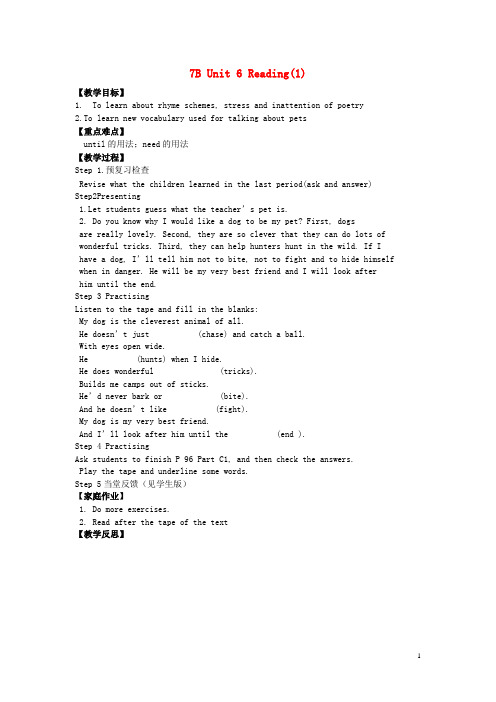
7B Unit 6 Reading(1)【教学目标】1. To learn about rhyme schemes, stress and inattention of poetry2.To learn new vocabulary used for talking about pets【重点难点】until的用法;need的用法【教学过程】Step 1.预复习检查Revise what the children learned in the last period(ask and answer)Step2Presenting1.Let students guess what the teacher’s pet is.2. Do you know why I would like a dog to be my pet? First, dogsare really lovely. Second, they are so clever that they can do lots of wonderful tricks. Third, they can help hunters hunt in the wild. If I have a dog, I’ll tell him not to bite, not to fight and to hide himself when in danger. He will be my very best friend and I will look afterhim until the end.Step 3 PractisingListen to the tape and fill in the blanks:My dog is the cleverest animal of all.He doesn’t just (chase) and catch a ball.With eyes open wide.He (hunts) when I hide.He does wonderful (tricks).Builds me camps out of sticks.He’d never bark or (bite).And he doesn’t like (fight).My dog is my very best friend.And I’ll look after him until the (end ).Step 4 PractisingAsk students to finish P 96 Part C1, and then check the answers.Play the tape and underline some words.Step 5当堂反馈(见学生版)【家庭作业】1. Do more exercises.2. Read after the tape of the text【教学反思】7B Unit 6 Reading(2)【教学目标】1 To read about animal behaviour2 To scan the text for specific information【重点难点】1 have to 与 must 的区别:2 be afraid of doing sth. 与 be afraid to do sth.【教学过程】Step 1.预复习检查Revise what the children learned in the last period(ask and answer)Step 2 Presenting1.Talk to students about gold fish.Does a gold fish chase another fish?Does a gold fish hide?Does a g oldfish bark? (Of course not.)Does a goldfish m eow? (No, she doesn’t.)2. At last, say: What a quiet goldfish! She doesn’t bark. She justbubbles and bubbles. She is not any trouble.Step 3 Practising1. As k students to repeat after the tape of ‘My Goldfish.2. Read ‘My Goldfish’ again and finish Page 98 Part C2.3. Read ‘My Gol dfish’ again and finish Page95 Part B1.Step 4 Presenting1. Say: We always think cats are lazy, because they likeany time anywhere. Where can you find cats sleeping?2. Show the students some pictures of table, chair, top of window-ledge, in the middle, on the edge, open drawer, empty some body’s lap, a cardboard box, our board.Step 5Activities1. Ask students to repeat “cats”.2. Read again and finish Page 95 B13. Finish exercises on workbook.Step 6当堂反馈(见学生版)【家庭作业】1. 助学案.2. 三训1课时【教学反思】牛津8A Unit 1 Reading(1)【教学目标】1.To learn new words to talk about people2. To develop the students’ abilities of li stening, speaking, readingand writing.3. To use adjectives to describe friends’appearance and characteristics.4. To encourage Ss to practice, participate, and co-operate in theclassroom activities.【重点难点】sense humour generous 的用法【教学过程】Step1. Warming-up & lead-inStep 2. Pre-readingActivity : competition (class work) I know you have learned the new words, Yes ? Let’s have a competition.Step 3. Reading So much for the new words . Good! Today we’ll learn two passages. Open your books and listen to the tape.let’s learn Passage1.Step 4. Reading ( Learn passage 2 about Max like learning passage 1.)Step 5. Post-readingActivity1: Discussion (Group work)Activity2: Let the Ss know how to describe their best friend. Activity3: Talk about the Ss’ best friends (group work)and play agame ( ask other Ss to guess)Step 6. Sum-upbecause they can help you and sh are both happiness and sadness with you, and we know how to describe our best friends. Now Let’s be friends!Step 7当堂反馈(见学生版)【家庭作业】1. Writing: ‘My best friend’.2. Learn the last passage by yourself.【教学反思】《牛津初中英语》8A Unit1 Reading(2)【教学目标】1. To grasp some useful expressions about describing a person个性化备课2. To learn how to describe friends.3. To help students to learn what kind of person shoul d be his/herbest friend and how to go on with friends well.【重点难点】1To learn some useful expressions and use them in differentcontext2.To learn how to describe friends.【教学过程】Step1 PresentationYeste rday we met three friends in ‘Teenagers’ Magazine.They’re Betty, Max and May. How much do you rememberthem?Step2: Language pointsT: Wonderful! You have a very good memory. Now let’s moveon to look at some useful phrases and sentences in the threearticles and learn to use them:Step 3: VotingT: We’ve learnt a lot about Betty, Max and May. If you canchoose only one of them as your best friend. who will youvote for? Why?Step 4: GameDivide the class into three or four competing teams.Each team can work out a description for the other teamsto guess. Give a score only for the first correct guess.Step 5当堂反馈(见学生版)【家庭作业】1. 完成本课时配套练习2. 预习Vocabulary【教学反思】。
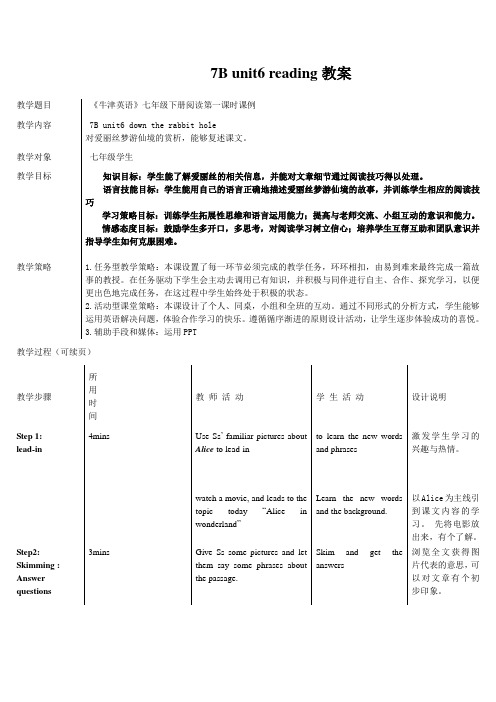
7B unit6 reading教案教学题目《牛津英语》七年级下册阅读第一课时课例教学内容 7B unit6 down the rabbit hole对爱丽丝梦游仙境的赏析,能够复述课文。
教学对象七年级学生教学目标知识目标:学生能了解爱丽丝的相关信息,并能对文章细节通过阅读技巧得以处理。
语言技能目标:学生能用自己的语言正确地描述爱丽丝梦游仙境的故事,并训练学生相应的阅读技巧1.学习策略目标:训练学生拓展性思维和语言运用能力;提高与老师交流、小组互动的意识和能力。
2.情感态度目标:鼓励学生多开口,多思考,对阅读学习树立信心;培养学生互帮互助和团队意识并指导学生如何克服困难。
教学策略 1.任务型教学策略:本课设置了每一环节必须完成的教学任务,环环相扣,由易到难来最终完成一篇故事的教授。
在任务驱动下学生会主动去调用已有知识,并积极与同伴进行自主、合作、探究学习,以便更出色地完成任务,在这过程中学生始终处于积极的状态。
2.活动型课堂策略:本课设计了个人、同桌,小组和全班的互动。
通过不同形式的分析方式,学生能够运用英语解决问题,体验合作学习的快乐。
遵循循序渐进的原则设计活动,让学生逐步体验成功的喜悦。
3.辅助手段和媒体:运用PPT教学过程(可续页)教学步骤所用时间教师活动学生活动设计说明Step 1: lead-in 4mins Use Ss’ familiar pictures aboutAlice to lead-into learn the new wordsand phrases激发学生学习的兴趣与热情。
watch a movie, and leads to thetopic today “Alice inwonderland”Learn the new wordsand the background.以Alice为主线引到课文内容的学习。
先将电影放出来,有个了解。
Step2: Skimming : Answer questions 3mins Give Ss some pictures and letthem say some phrases aboutthe passage.Skim and get theanswers浏览全文获得图片代表的意思,可以对文章有个初步印象。
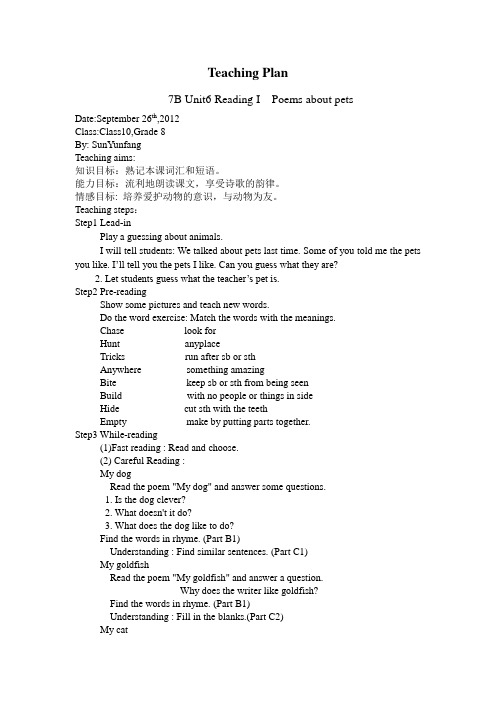
T eaching Plan7B Unit6 Reading I Poems about petsDate:September 26th,2012Class:Class10,Grade 8By: SunYunfangTeaching aims:知识目标:熟记本课词汇和短语。
能力目标:流利地朗读课文,享受诗歌的韵律。
情感目标: 培养爱护动物的意识,与动物为友。
Teaching steps:Step1 Lead-inPlay a guessing about animals.I will tell students: We talked about pets last time. Some of you told me the pets you like. I’ll tell you the pets I like. Can you guess what they are?2. Let students guess what the teacher’s pet is.Step2 Pre-readingShow some pictures and teach new words.Do the word exercise: Match the words with the meanings.Chase look forHunt anyplaceTricks run after sb or sthAnywhere something amazingBite keep sb or sth from being seenBuild with no people or things in sideHide cut sth with the teethEmpty make by putting parts together.Step3 While-reading(1)Fast reading : Read and choose.(2) Careful Reading :My dogRead the poem "My dog" and answer some questions.1. Is the dog clever?2. What doesn't it do?3. What does the dog like to do?Find the words in rhyme. (Part B1)Understanding : Find similar sentences. (Part C1)My goldfishRead the poem "My goldfish" and answer a question.Why does the writer like goldfish?Find the words in rhyme. (Part B1)Understanding : Fill in the blanks.(Part C2)My catRead the poem "My cat" and choose the right places.Find the words in rhyme. (Part B1)Understanding : talk about cats in pairs. (Part C3)S1: Where do cats sleep?S2: Cats sleep ...Step4 After-readingSome more exercises about poems.(1) Enjoy the song:Twinkle twinkle little star.(2) Find the words in rhyme(3)Fill in the blanks.Step5 SummaryWhat have we learned this class?Step6 Classwork.。
牛津英语7B Unit6 Reading1教案牛津英语7B Unit6 Reading1教案学习目标:1 通过学习宠物诗,我们能更加了解宠物,也让我们能够更好地与人类的朋友---动物,友好相处!2 掌握下列词、词组的用法:Chase wide hunt hide trick build camp stick bite fight troubleBubble anywhere middle empty cane词组: until the end课前自主学习:请通过Internet查询有关宠物的诗歌,在课堂上进行交流。
体验与实践一、预习情况交流将下列词组翻译成英语:1 睁大眼睛▁▁▁▁▁▁▁2 玩精彩的把戏▁▁▁▁▁▁▁▁3 照料▁▁▁▁▁▁▁4 知道最后▁▁▁▁▁▁▁▁5 一只兔子笼▁▁▁▁▁▁6 打开抽屉▁▁▁▁▁▁▁▁7 在中间▁▁▁▁▁▁▁ 8 在边上▁▁▁▁▁▁▁▁二、重点热点点击1. He doesn’t just chase and catch a ball . 他不是只追球和接球。
Just :“ 只,仅仅”相当于 only 。
这句话是说: He can run after a ball and do other things .(他能追球同时能做其他的事。
)2. With eyes open wide , he hunts when I hide . 当我躲起来时,他睁大眼睛找我。
“ With ……”在句子中作伴随状语,表示伴随状态。
如:My father often comes into our flat with a newspaper in his hand .我父亲进家门时手里经常拿一份报纸。
And I’ll look after him until the end . 我将要照顾他到最后。
look after 意思是“照顾,照看,保管”,相当于 take care of ,如:Please help me look after my baby .请帮助我照顾好我的小孩。
电子备课格式(最新)课题7B unit6 Reading(1) 主备主核使用者课型new 使用日期【学习目标】1. To read and understand the story.2. To complete the exercises by themselves.第一次集体备课(通案)第二次备课(个案)【导入新课】1.What’s your favourite activity at school?2.Why do you like it best?【板书课题】Unit 6 Outdoor fun Reading(1)【学习目标】1. To read and understand the story.2. To complete the exercises by themselves.【自学指导】1. Read Paras. and answer the questions1)What did Alice see a white rabbit?2)What did the rabbit say?3)What was the rabbit going to do? Canyou guess?2. Read Paras 2-3(Outside the hole)1)What did the rabbit say?2)Where did the rabbit go?3)Why did Alice jump down the hole?3. Read Paras4-5 (Inside the hole),fill in the table.There were doorsall around,butAlice saw a smallkey on a table,Alice saw a lovelygarden on theother side, andtried to go throughthe door,4. Post-reading Put the sentences in the correct order1)Alice ran across the field after therabbit. 学生活动指导:The students have ten minutes to read the text. Then try to answer these questions1.Discuss in groups.2..Summery the answers.3.As help s Ds complete the questions.2)The strange rabbit surprised Alice.3)Alice sat by a river with her sister.4)Alice opened a small door with the key.5)Alice could see no one in the hall.6)Alice found a small key on a table.7)Alice jumped down the hole after therabbit.8)Alice saw a white rabbit passing by.Complete Part B1、B2、B35. Retell the story6.Remember these phrases.1.sit by a river2.see a rabbit passing by3.run across4.jump down5.get away6.fall7.locked 8.hit9.find herself alone 10.go through the door11.take a watch out of its pocket12.run across the field 13.It surprised Alice14.run after the rabbit 15.jump down a big hole16.find herself alone in a long, low hall17.notice a small door 18.try to go through the door【堂清知识】Understand and try to retell the story.Remember the phrases.【当堂检测】选词填空pass by,jump down , go through the door, fall , get away , run across , find herself alone, hit , locked,1.The doors were_______________________.2.She _________________________the field afterthe rabbit.3.Alice tried to__________________ but she wastoo big.4.Alice didn’t want to let the rabbit______________, soshe___________.5.She saw a rabbit in acoat___________________.6.She__________________ when Alice was inthe hole. 学生活动指导:1,The students complete part B 1.2.3.by themselves.2.Discuss in groups.学生活动指导:The students have ten minutes to read the text. Then find out the phrases.7.She_____________for a long time, and thenshe___________ the ground.日清内容一.单项选择1.Who took the apples___ the box.A. outB. out ofC. OutsideD. away2. The cat jumped into the house_________ the window.A. inB. acrossC. through C. near3. Tom__________ his head on the wall.A.is hitingB. hittingC.hitD. hitted4. Alice_________ into a rabbit hole.A.fallingB. fallC. FalledD.fell5. He________ and_______ a sound.A.heard; listenedB. listened; heardC. listened; 二.Understand the story and read it .then try to recite.第三次备课(反思)得:大部分学生对本课内容掌握较好,能理解课文,并能完成任务。
7B Unit 6 Reading(1)教学案兴化市英语中心备课组——刘丽君7B Unit 6 Reading(1)学案班级________________ 学号__________________ 姓名___________________ 1.Ask and answerA: What outdoor activity would you like to try?B: I want to….A: Why?B: Because…2.Listen to the tape and find the answers to the following questions:(1) When did Alice see the white rabbit?_______________________________________________________________________ (2) Can Alice go through the small door?_______________________________________________________________________ 3. Read Part 1 and answer the following questions(1) Where did Alice sit?_______________________________________________________________________ (2) What did Alice see?_______________________________________________________________________ (3) What did the rabbit say?_______________________________________________________________________ (4) What did the rabbit do?_______________________________________________________________________ 4. Read Part2 by yourselves and finish the table.5. Read Part 3 and tell true or false.(1)It took Alice a long time to hit the ground.(2)Alice talked to the rabbit in the hole.(3)Alice opened a small door with the small key on a table.(4)Alice went through the door6. Put the sentences in the correct order. Write the numbers 1—8 in the blanks.____ a Alice ran across the field after the rabbit.____ b The strange rabbit surprised Alice.____ c Alice sat by a river with her sister.____ d Alice opened a small door with the sky.____ e Alice could see no one in the hall.____ f Alice found a small key on a table.____ g Alice jumped down the hole after the rabbit.____ h Alice saw a white rabbit passing by.7. Discussion:Can Alice go through the door at last?If she can, how an she do this?________________________________________________________________________ ________________________________________________________________________ _______________________________________________________________________ _______________________________________________________________________ 8. Discussion:If you're Alice, what will you do when you see such a strange rabbit?________________________________________________________________________ ________________________________________________________________________ _______________________________________________________________________ _______________________________________________________________________ 9. Read and complete the passage about the storyOne Sunny day, Alice ______by a river with her sister when she _______ a sound. She ______ up and ______ a strange rabbit passing by. She _____ up and _____ acrossthe field after the rabbit. Then she _______ down a hole after the rabbit. She ____ fora long time. At last she _______ herself in a hall. She ______ a small door and she could see a lovely garden on the other side, but she couldn't go through the door.10. Homework:1) Recite the new words and read the story.2) Do Part B3 on Page 72.3) Writing:Try to write the next part of story._______________________________________________________________________ ________________________________________________________________________ ________________________________________________________________________ ________________________________________________________________________ ________________________________________________________________________ ________________________________________________________________________ ________________________________________________________________________。
7B Unit 6 Reading1教学设计
新坝初中严红波
(一)教学设计
一、Teaching Objectives:
1. To learn some words and expressions: outdoor activities, complain, camping, riding, skating, cycling.
2. To be able to talk about favourite outdoor activities in English..
3. To understand the importance of doing outdoor activities.
二、Teaching key and difficult points:
To use what they have learned to talk about their favourite outdoor activities correctly.
三、Teaching aids:
Pictures slides a tape recorder
四、Teaching Procedures:
Step 1 Lead-in
Lead in outdoor activities by talking with students and present new words: complain, cycling, outdoor activities.
(设计意图:通过女儿的一张照片自然引出本课话题,并呈现生词。
)
Step 2 Presentation
1. Present some outdoor activities by showing some pictures, such as riding, camping, skating, jogging and swimming.
2. Play a guessing game.
(设计意图:让学生能增加一些有关这些户外活动的信息,为以后的对话作一下铺垫。
同时调节一下课堂气氛,激发学生的参与欲望。
)
3. Ss talk in pairs by using the following dialogue as a model.
A: What outdoor activity would you like to try?
B: I want to go skating.
A: Why?
B: Because I think skating is an exciting activity in winter. It is like dancing on ice.
(设计意图:让学生用所学知识谈论户外活动,投入到实践运用中去。
)
Step 3 Practice
1. Listen and answer.
Q: What outdoor activity does Amy want to try?
What about Daniel?
2. Read and answer:
Q: Why does Amy want to go riding? Why would Daniel like to go camping?
3. Help solve the problems students raised up after reading the dialogue.
4. Ss read the dialogue in pairs.
(设计意图:训练学生听说能力,并鼓励学生大胆说英语。
)
Step 4 Presentation
1. Present picture one of the comic strips and ask
What outdoor activity are Eddie and Hobo doing now?
2. Listen and answer:
Q: Does Eddie enjoy it?
3. Read and answer:
Q: Eddie thinks the bag is heavy but Hobo doesn’t think so. Why?
4. Act out the dialogue.
(设计意图:引出本单元话题——户外活动的乐趣,鼓励学生大胆表演,体验英语学习的乐趣,同时让学生体会到英语课堂带来的成就感和满足感。
)
Step 5 Activities
1. Make a survey about students’favourite outdoor activities in groups of four and let some of
的检测反馈学生知识的掌握情况。
)
2. Discussion: Why do we need to do outdoor activities?
What should we pay attention to when doing outdoor activities?
3. Recommend two books to Ss. One is Alice in Wonderland, the other is The travels of Marco Polo. Encourage Ss to read more books, try more outdoor activities.
(设计意图:引导学生在做户外活动中要坚强,勇敢,自信,要重视团队合作,正好适时地进行情感教育。
同时,轻轻点出本单元Reading中即将要学的内容和Integrated skills 中要讲到的信息,使得学生对后面的学习有了更多的期待。
)
Step 6 Homework
Write something about your partners’favourite outdoor activities.。